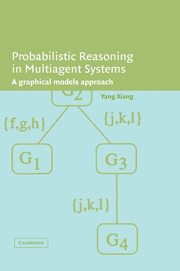Book contents
- Frontmatter
- Contents
- Preface
- 1 Introduction
- 2 Bayesian Networks
- 3 Belief Updating and Cluster Graphs
- 4 Junction Tree Representation
- 5 Belief Updating with Junction Trees
- 6 Multiply Sectioned Bayesian Networks
- 7 Linked Junction Forests
- 8 Distributed Multiagent Inference
- 9 Model Construction and Verification
- 10 Looking into the Future
- Bibliography
- Index
Preface
Published online by Cambridge University Press: 31 August 2009
- Frontmatter
- Contents
- Preface
- 1 Introduction
- 2 Bayesian Networks
- 3 Belief Updating and Cluster Graphs
- 4 Junction Tree Representation
- 5 Belief Updating with Junction Trees
- 6 Multiply Sectioned Bayesian Networks
- 7 Linked Junction Forests
- 8 Distributed Multiagent Inference
- 9 Model Construction and Verification
- 10 Looking into the Future
- Bibliography
- Index
Summary
This book investigates opportunities for building intelligent decision support systems offered by multiagent, distributed probabilistic reasoning. Probabilistic reasoning with graphical models, known as Bayesian networks or belief networks, has become an active field of research and practice in artificial intelligence, operations research, and statistics in the last two decades. Inspired by the success of Bayesian networks and other graphical dependence models under the centralized and single-agent paradigm, this book extends them to representation formalisms under the distributed and multiagent paradigm. The major technical challenges to such an endeavor are identified and the results from a decade's research are presented. The framework developed allows distributed representation of uncertain knowledge on a large and complex environment embedded in multiple cooperative agents and effective, exact, and distributed probabilistic inference.
Under the single-agent paradigm, many exact or approximate methods have been proposed for probabilistic reasoning using graphical models. Not all of them admit effective extension into the multiagent paradigm. Concise message passing in a compiled, treelike graphical structure has emerged from a decade's research as one class of methods that extends well into the multiagent paradigm. How to structure multiple agents' diverse knowledge on a complex environment as a set of coherent probabilistic graphical models, how to compile these models into graphical structures that support concise message passing, and how to perform concise message passing to accomplish tasks in model verification, model compilation, and distributed inference are the foci of the book. The advantages of concise message passing over alternative methods are also analyzed.
- Type
- Chapter
- Information
- Probabilistic Reasoning in Multiagent SystemsA Graphical Models Approach, pp. ix - xiiPublisher: Cambridge University PressPrint publication year: 2002

